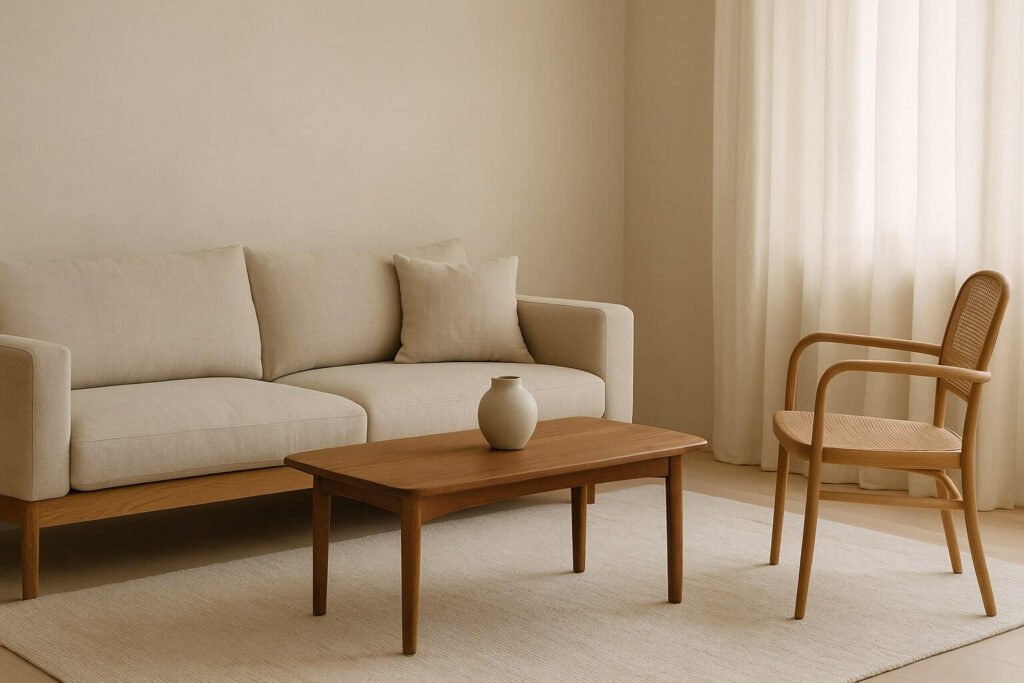In a world that often moves too fast and decor trends that swing wildly between extremes, the Japandi transitional living room has found its moment. It’s not just a style. It’s a slow-living mindset wrapped in clean lines, softened corners, and textures that invite you to stay. At its core, Japandi transitional living room design blends the essentialism of Japanese interiors, the tactile warmth of Scandinavian comfort, and the subtle elegance of transitional architecture. The result is a space that feels grounded, fluid, and quietly rich in character.
What makes this approach so magnetic is its refusal to shout. It whispers. It doesn’t demand attention, it earns it by giving you space to breathe. It’s no surprise that design circles across London, Copenhagen, and Kyoto have all embraced this direction, merging craftsmanship with comfort, and restraint with rhythm.
Japandi meets transitional: a philosophy of calm living
The heart of a Japandi transitional living room lies in its philosophy, not just its palette. Picture a space with low-slung furniture, sun-warmed oak floors, maybe a ceramic tea set quietly resting on a wide, handmade coffee table. The room doesn’t show off. It welcomes. Walls are usually soft, chalky neutrals like ecru, light clay, or mist grey. The atmosphere feels quiet but layered. It’s not empty, it’s intentional.
From the Japanese side, you’ll find simplicity, symmetry, and nature-infused materials. Think shoji-style room dividers, linen drapery, and timber that shows its grain. From the Scandinavian influence, hygge makes an appearance with wool throws, boucle textures, and sofas that say sit, don’t pose. Transitional design enters the chat with timeless silhouettes, slightly arched doorways, and occasional tailored details. It doesn’t interrupt, it guides. You might see a wingback chair reupholstered in flax linen or a marble fireplace with just a whisper of classical detail.
The Japandi transitional living room is not just a curated look. It’s a curated lifestyle. It embraces light but doesn’t glare. It uses contrast but never clashes. A black matte lamp might sit on a pale timber console. A soft olive velvet cushion leans against a stone-coloured backdrop. There’s movement and stillness. There’s space and shape. Most importantly, there’s harmony.
How to shape your own Japandi transitional living room
Start with your anchor. Choose one significant piece that feels like the soul of the room. That might be a low oak sofa with slipcovered cushions in natural cotton, or a substantial walnut coffee table that invites slow conversation. Around it, everything else should complement, not compete. In this style, every item needs a reason for being.
Let the palette lead. Go with 70 percent light neutrals, 20 percent natural woods or warm mid-tones, and just 10 percent contrast. This could be a single charcoal vase, a mossy green armchair, or a dark clay rug grounding the space. Earth tones like rust, sage, sand, and stormy blue feel particularly at home here. They work best when they echo something from nature, like a pine forest or a river stone.
Now comes texture. You want layers that add depth without fuss. Try a jute rug underfoot, soft wool throws over the arm of a curved armchair, or slatted wood panels behind a media unit. Accent lighting is key. A paper lantern offers a glow that feels more like moonlight than spotlight. Use wall sconces or under-shelf LEDs to light textures rather than the entire room.
Transitional design opens the door to gentle nods from history. Don’t be afraid to include a plaster medallion ceiling, shaker-inspired joinery, or tailored curtains pooling slightly at the floor. But keep it tonal. The more unified your colour story, the more these elements feel like they belong together.
One often-overlooked element in Japandi transitional living rooms is silence. Not in sound, but in space. An undecorated wall, a console table with just one sculptural vase, or a reading nook with a single chair and lamp can be more impactful than an entire gallery wall. The pause, the breath between visual elements, that’s where this style finds its poetry.
If you’re considering greenery, choose thoughtfully. One tall sculptural plant, like a rubber tree or a trailing pothos, does more than a dozen mismatched pots scattered across the room. Biophilic design is about connection, not clutter. Let the foliage be a punctuation mark, not a paragraph.
Living beautifully, intentionally
Japandi transitional living room design is less about following a checklist and more about editing your space toward meaning. It asks you to slow down. To choose materials that feel good, not just look good. To honour craftsmanship over mass production. To notice the way morning light falls across a wooden bench or how a linen curtain shifts with the breeze.
In many ways, it’s a return to design as experience, not just image. It’s what happens when aesthetics grow up, when style starts listening instead of speaking. As more people crave calm in a fast world, Japandi transitional living rooms offer refuge. Not in grand gestures, but in the beauty of enough.
Let your space speak quietly. That’s where the luxury lives now.


